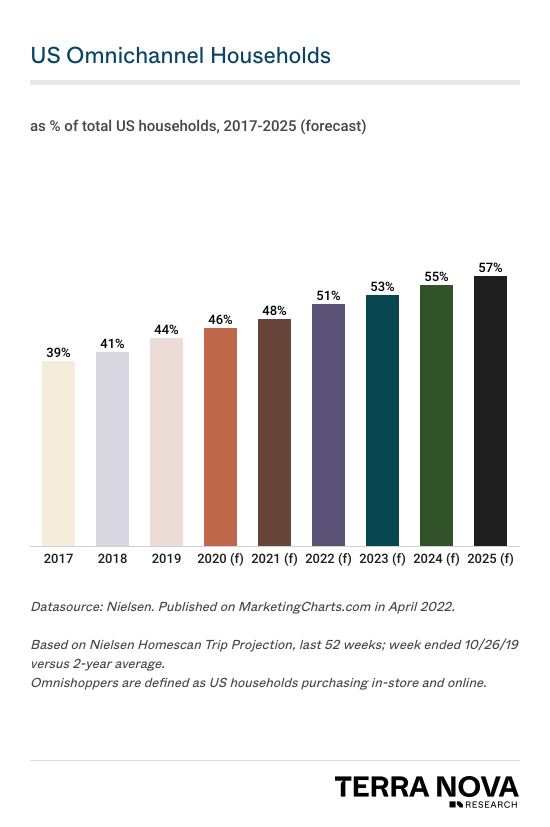

Contents
ABSTRACT
KEY POINTS FROM ASIF MOOSANI'S POV
Why is inventory planning for omnichannel retailers such an important category moving forward?
Omnichannel retailers, not pure e-commerce players, capture the lion's share of retail spend today.
Asif Moosani~quoteblock
- This scratches the surface of a multi-trillion dollar market, and the reality is that it is still underserved, says Moosani. “Everyone has seen the creation of e-commerce as a category and innovation has flocked to it, leading to crowded competition," he says. "The piece they miss is that omnichannel retailers, not pure e-commerce players, capture the lion's share of retail spend today. Yet innovation for omnichannel has been quite nascent until very recently. That’s where the real whitespace exists. Even after accounting for non-serviceable customers, the addressable opportunity is monumental. Specifically, if you look at the bookends of this market, some of the largest retailer players may want to build an inventory-planning tool in-house. At the bottom, there are retailers too small to adopt dedicated inventory software. Accounting for these bounds, we estimate there are still over 45,000 retailers equipped to be perfect customers.”
- A confluence of all the technologies around data and AI have taken inventory planning to a new level. “ML models can now do granular demand forecasting: store-specific and SKU-level,” says Moosani. “There are already ERP systems, middleware providers, and data warehouses that are collecting and organizing the data for the models to use. This AI sits on top of these systems. Now we have all the data we need to make all these inventory decisions — down to the SKU level.”
What are some of the key use cases that define this category?
- Two principal use cases shape the adoption of inventory-planning software: in-season optimization and pre-season planning, according to Moosani. In the retail world, especially in apparel, inventory is managed according to distinct seasons. Seasonal events — changes in weather, holidays, or sales (Black Friday) — trigger a wave of orders and stock turnover. Second, and increasingly important as consumers grow more fickle, inventory tweaks must happen when a season is in full swing. Ideally, even individual products should move to meet demand at a specific store. All of it must be orchestrated across physical stores and e-commerce. While different forms of analytics can be bolted on, “the core of the initial offering is minimizing stockouts and excess inventory, via in-season optimization and transfers,” he says.
- Inventory planning platforms can complement incumbent systems and provide holistic operations support. An example in this category is James Theuerkauf’s company, Syrup Tech, in which Gradient Ventures led a $6.3M Seed raise. “They sit on top of existing ERP systems and middleware providers, and provide holistic analytics from planning to end-to-end inventory management. This ability to enhance existing stacks is a really strong go-to-market wedge.”
What are some of the potential roadblocks for this thesis?
- Sales processes are uniquely challenging in this market. “Though the pain points and inefficiencies are costly, buyers in this market have a strong degree of hesitation in adopting new technologies,” says Moosani. “For a new vendor expecting to break into this market, it involves a lot of one-on-one conversations, and clearly demonstrating value. It’s not easy. There’s a lot of spending discipline amongst retailers who thrive in a low-margin business. Inventory planning teams have grown weary of offerings that claim to optimize their efforts because many previous offerings bear such a heavy cost of implementation that they prevent teams from ever realizing any gains – and even those that make it across the implementation line often operate as black-box solutions that don't provide any visibility on how they create their recommendations, nor do they work within their workflows. All around, this creates a challenging process to get them on board.”
VISUAL: THE GROWTH OF OMNICHANNEL RETAIL
While e-commerce growth is more buzzy, retail watchers have spotted a broader trend that is happening simultaneously: the growth of omnichannel retail. In a few years, the majority of US households will be omnichannel shoppers, and that growth will continue.

IN THE INVESTOR’S OWN WORDS

Inventory is a vulnerable point for any retailer, and it’s a problem that technology can address. They have to make the ship turn on a dime as — trends, tastes, sizes — everything changes with more and more speed. Retailers know that they can’t hire themselves out of this. Even the largest inventory teams are 40 to 100 people..
Even with technology, a lot of planners are heavily reliant on inventory solutions that were built in the 90s.
As a result, many inventory planners don't get the chance to think about the bigger picture of their business and how they can adapt to changing consumer needs. Instead, they are constantly filling in holes and addressing gaps.
For example, if one store runs out of a particular style of jeans, but another location nearby has extra pairs, they may want to move the inventory between stores – while it seems simple, most retailers don't have the sophistication to do this. That creates massive cost and inefficiency, leaving a lot of dollars on the table. Particularly in today’s macroeconomic environment, brands are acutely focused on optimizing cash and profitability, and thus primed to adopt solutions to instill inventory excellence.
MORE Q&A
Q: How do companies expect to overcome resistance to new software in the retail sector?
A: Companies have to demonstrate that they can drive double-digit improvements and brief time-to-value. In deployments, they must get clients up-and-running quickly, require minimal overhead, and make actionable recommendations immediately. Customers should not have to wait for a cycle to end to see order-planning recommendations for an upcoming season. One of the key differentiators for one of our portfolio companies, Syrup Tech, is their ability to do in-season order planning. When working with new clients, they can promise better recommendations that will save them money, in a week. That immediate value-add is a critical aspect.
Q: Retail is at the forefront of some of the recent economic shocks: supply-chain delays, inflation, worker shortages. What is the impact for this category?
A: Macro headwinds are bringing inventory-optimization topics front-of-mind for retailers. There’s a clear logic for adopting these tools that can reduce waste, automate manual tasks, and increase the chance something will be in-stock without rushing to meet demand. All of that will contribute to reduced costs, and increased revenues. Improvement on both sides.
There’s also the predictive power you can harness. You can predict seasonal and other trends, including size and color. They provide very direct recommendations to the merchandise planner, which will support sales. It allows you to zoom out and focus on resilience as a business rather than running in circles trying to remain a step ahead of the consumer.
WHAT ELSE TO WATCH FOR
Watch for incumbent ERP tools and software providers to challenge new entrants more directly. “This is the other side of the coin,” says Moosani. “The incumbents may get more aggressive in chasing this opportunity. That said, this is a very different problem set compared to retail supply chain and ERP. It involves forecasting in-season and out-of-season — it is an issue very specific to retail. The up-and-coming companies are leaning heavily into AI-powered recommendations where they can gain a head start. At the end of the day, it’s relatively easy to trace the value created. So, the competition will be won by whoever captures the hearts of inventory planners — working for them rather than replacing them.”
Look for innovation in omnichannel as the growth paradigm in retail tech. Omnichannel retail’s dominance over pure e-commerce provides a strong tailwind for a new generation of retail software, including inventory planning. Due to the historical attention on e-commerce, there has been an underappreciation of how much inefficiency there is in omnichannel operations. Sparked by the supply chain crunch, industry operators are now beginning to truly focus on innovating here. Expect savvy investors and founders to back products that solve the unique problems of omnichannel – this is where the next unicorns will emerge.
STARTUPS MENTIONED IN THIS BRIEF
